|
The
Flash Gordon and Buck Rogers movie
serials were deliberately crafted for adolescent
male fans. Early
commercial Science-Fiction was often sold as
an offshoot of so-called "Boy's Entertainment."
This profitable genre included great writers
like H.G. Wells and Jack London, plus facile
entertainers like Edgar Rice Burroughs and Rafael
Sabatini. There were many entrepeneurs who hired
anonymous professional writers to hack out innumerable
stories featuring popular copyrighted characters,
like Doc Savage and The Shadow,
plus magazines which sold recycled plots, slightly
masked by eccentric variations of archetypical
heroes, heroines, and villains.
Hugo Gernsback published Amazing Stories,
a pulp magazine featuring "Scientifiction"
stories as reprints from Jules Verne, Wells,
Burroughs, etc. plus new tales, like the outrageously
galactic Skylark series by E.E. (Doc)
Smith. One odd story graced the pages of Amazing
in the summer of 1928 -- Armageddon 2419
A.D. by Phil Nowlan, which introduced somnambulistic
time-traveller Anthony (later Buck) Rogers to
the world.
After
a sequel demonstrated the character's appeal,
John F. Dille, president of the National Newspaper
Service turned him into a syndicated feature,
drawn by Dick Calkins. It debuted on January
7, 1929 as Buck Rogers in the 25th Century
A.D. -- the first science fiction comic
strip. Harold Foster's magnificently-drawn visualization
of Tarzan began on that same date too,
but Calkins was no Foster. Despite the sometimes-crude
drawing, Buck Rogers epitomized the Space
Opera, for good or bad, over 38 years in the
mind of the American public, until July 8, 1967,
long after Nowlan and Calkins had been replaced
by Rick Yager, George Tuska, Murphy Anderson
and others.
King Featues Syndicate challenged Buck's predominance
with
Flash Gordon,
a beautifully-drafted Sunday strip which primarily
ran in the Hearst papers. The same company also
competed with Tarzan by running Jungle
Jim on the same page. Both features were
illustrated by the brilliant Alex Raymond.
In the genre of "Boy's Entertainment,"
women
characters were generally marginalized by the
producers, editors, artists, and writers for
various socio-economic reasons, as well as priggishness,
prudery, and prejudice. This psychological repression
made for some interesting results at times,
but there was very little variation among stock
passive heroines or scheming villainesses. Spitfires
of the Spaceways discusses and illustrates
a few preturbations of these benighted stereotypes.
Wilma Deering of Buck Rogers
Wilma wasn't exactly the typical Lady In Distress,
although she specialized in finding trouble.
(She was a soldier after all, and an officer
to boot!) Deering seemed to be a combination
of Aviatrix and Flapper from the Roaring 20's,
in that she was competent with futuristic
weaponry and
equipment, but also seemed to suffer repeated
streaks of bad luck whenever the bad guys went
about their bad business. Buck Rogers rescued
her from many bad situations in the newspapers.
As a native of the 25th Century, Deering knew
more about
life in her time
than 20th Century
relic Rogers could ever have conceived, and
was an indispensible ally to him -- saving his
skin more than once. In lockstep with the conventions
of the times, there was no romance between the
two principals, or anybody else for that matter.
She was almost the equivalent of a matinee cowboy's
comic sidekick, except she was a lady, and rarely
cracked jokes.
Wilma was most often a sibling-like prescence
-- so much so that her BROTHER was the protagonist
of many newspaper adventures. Other times she
was so sexually neutral, it was like Buck had
taken his mom along with him.
In the Buster Crabbe serial of 1939. She was
quietly effective, and took initiative now and
then -- even breaking jail to rescue Buck, as
her Spitfire chapter shows!.
There was one awkward moment when Crabbe ALMOST
kissed big-band singer Constance Moore, but
it passed quickly. I personally thought it was
the least he could have done for her -- she
looked awfully lonely as the one solitary woman
in the entire film!
|
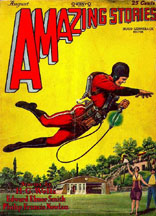
Frank
R. Paul's Rocket Pack flier was the model for
Nowlan & Calkins' Buck Rogers.

Buck & Wilma flying with
their own Rocket Packs.
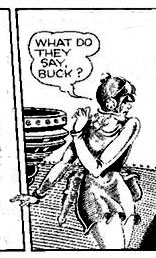 Wilma
Deering, Bucks' co-adventurer, by Dick Calkins
Wilma
Deering, Bucks' co-adventurer, by Dick Calkins
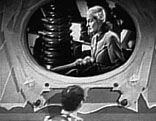
Wilma, as played by Constance Moore in 1939
|
Dale Arden of Flash Gordon
This character was an utterly objectified Lady In Distress,
but she had to fight alongside of her Action Hero many
times. Dale
was an idealized model woman, drawn from studio models.
Her physical attributes were prominent, but so were
those of Flash -- who was also drawn from models in
Alex Raymond's studio. The
sinuous beauty of this couple was definitely one of
the attractions of the comic strip.
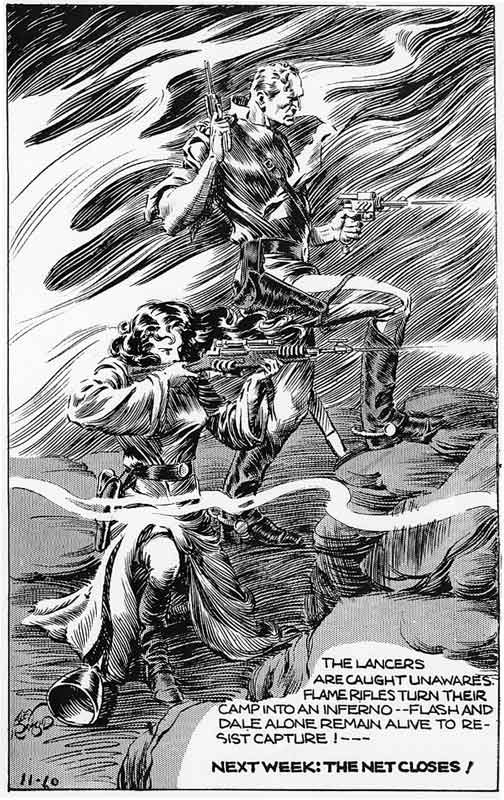
The fictional characters obviously cared about each
other (within the repessive limits of the genre) but
the writers of the Flash Gordon movies didn't
give Dale Arden all that much thought, especially the
blonde version -- she was most often a prisoner, or
drugged, or hypnotized, or otherwise helpless to a fault.
(The writers' fault.) After the studio dyed her hair
the proper color, she had some Spitfire moments,
just like her model in the comic pages, but they were
still few and far between. Besides brunette Dale Arden's
escapade as a bombadier on Mars, which is illustrated
in its own Spitfire chapter, she unsuccessfully
attacked Flash with a knife while under the influence
of some conjuror's vapors. On her later mission to Planet
Mongo, she got into several slap-fights with Ming's
secret agent Lady Sonja, but was overpowered by burly
guards or gas bombs before doing any damage. Dr.
Zarkov championed Dale Arden as a valuable comrade in
battle, prompting Mongo's Ice Queen to retire from romance,
war, and the rest of the whole darn serial as well.
Dale
also flew the getaway Rocket when Flash blew up Ming's
control tower, with Sonja and Ming inside, which wrote
FINI for the lady spy!
Dale
Arden Under the Influence
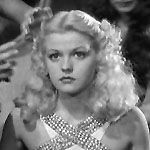
Jean
Rogers as Dale 1 |
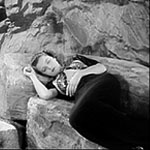
Jean
Rogers as Dale 2 |
|
Dale
Arden Taking the Initiative
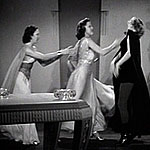
Take
THIS, sneaky Sonja! |
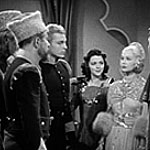
The
frigid Queen loses to Dale 3 |
|
Princess
Aura of Flash Gordon
Priscilla
Lawson re-created Alex Raymond's petulant royal troublemaker,
right off the pages of his first Flash Gordon adventures.
Lawson was the winner of a beauty contest, and secured
this high-visibility role almost immediately upon her
arrival in Hollywood. Princess Aura is Spitfire Number
One by acclamation, and a whole illustrated essay
is dedicated to her,
with more pictorial impressions of her many meddlesome
heroics and perfidies yet to come. As George Clinton
later sang: The Girl Is BAD!
Aura
1 & Dale 1 beneath Ming's Palace

Aura
knows your secrets -- ALL your dirty secrets! |
|
In
the Sky City of the Hawkmen
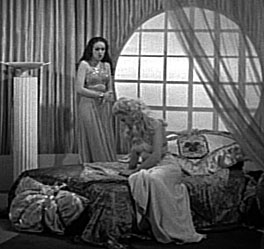
Watch
out Dale -- Aura wants Flash for herself! |
|
Unfortunately, both Alex Raymond and Universal Studios
gradually drained the vital rambunctiousness out of
our Princess. She became prim, proper, and insipidly
unrecognizable by the time the last serial was made
in 1940, in which Shirley Deane played Aura 2. Please
note that Ms. Deane was NOT to blame for bad screenwriting,
or the abandonment of a perfectly good character by
it's creators.
Dale
3 & Aura 2 as Allies and Friends
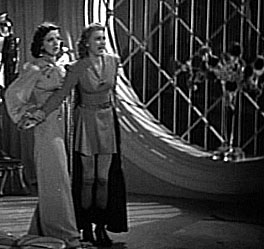
Careful
Flash -- the door is booby-trapped! |
|
Aura
2 complains to Emperor Ming
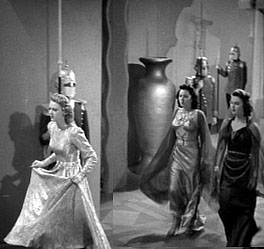
Same
old $#@! place -- soldiers and harem dancers! |
|
Scroll Down for even MORE Spitfires
of the Spaceways!
Witch
Queen Azura of Flash Gordon
Alex Raymond and ghost writer Dan Moore's echo of Haggard's
SHE, with more than a few overtones of Burroughs'
many lost and hidden matriarchs -- Azura was an uncomfortably
aggressive and kinky monarch of Mongo in the Sunday
strip, but she was much more repressed as a Martian
magician in the movie serial.
Queen
Azura of Mars
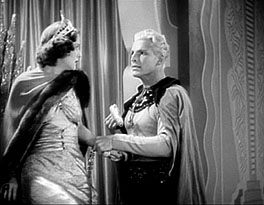
Universal's
Azura redeemed herself at the end.
|
|
Queen
Azura of Mongo
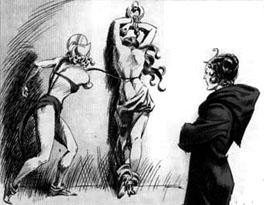
Raymond's
Witch Queen was outright sadistic. |
|
The censors allowed Azura: Queen of Magic, to
be treacherous and mean -- but NOT sexy, plus they removed
the word "witch" from the script. Those phallic
Ray Guns were hilarious. They missed some inadvertently
Sapphic imagery scattered around the episodes. A few
pretty models, hired as extras, were clothed like Ming's
harem girls in the previous adventure, and stood in
attendance by Azura's throne. Except for Dale Arden
2 (Jean Rogers as a brunette), they were the only female
characters in the whole second serial. Send a message
to Yvonne Craig -- Mars REALLY needs women!
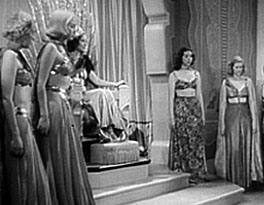
Space-tyrants
seem to require half-clad attendants.
|
|
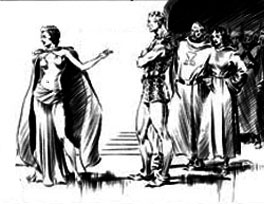
Mongo's
Azura was too hot for Hayes' Hollywood.
|
|
Lady
Sonja of Flash Gordon
Busy
B-Movie actress and popular WWII pinup model Anne Gwynne
played Lady Sonja, the last villainess-spitfire in Flash
Gordon's trio
of chapter serials, at the age of twenty. Sonja was
a minor temptress and traitor in the strip. Lady Sonja
of the movies was more like Milady De Winter, the beautiful,
but deadly, arch-spy in Dumas' Three Musketeers,
and it literally took a bomb to finally stop her. She
perished at the side of her Emperor in the Saturday
serial, but was executed at Ming's orders at the bitter
end of her Sunday adventure.
Lady
Sonja by Alex Raymond
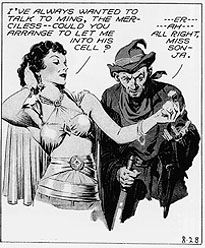 |
Anne
Gwynne as a Pin-up
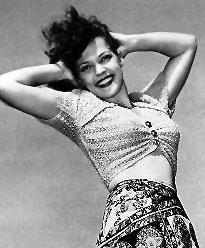 |
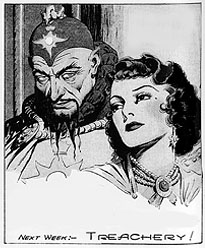 |
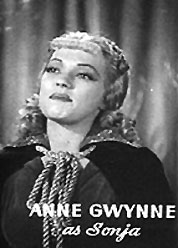 |
|
A crime-by-crime analysis of her misdeeds is not on
Spitfires of the Spaceway's agenda, but she's
already featured on Princess Aura 2's page, and she'll
share some of Dale Arden 3's upcoming picto-saga too.
Gwynne worked well with the swggering Charles Middleton,
so it was sad the producers didn't write more scenes
for the two of them. Sonja's perfidious partner in most
episodes was Captain Torch, a character without much
fire -- the less said about him the better.
The
Outer Space Dancers of Just Imagine and
Flash Gordon
Before
the cliches of the Space Opera were fully formed, Fox
made a Science Fiction musical comedy, perhaps trying
to attract the audiences for Fritz Lang's respected
Metropolis and Girl In The Moon.
The movie was named Just Imagine, and was a flop
in the darkening Depression days of 1930, but footage,
props, and special effects from the project were used
in other productions for a decade. The
Buck Rogers serial used Just Imagine's
Art Deco version of a future New York as Killer Kane's
25th Century capitol city.
Besides using Just
Imagine's
Rocket Ships, the Flash Gordon serials also used
and re-used some dance sequences. Universal also borrowed
spacey Ziegfeld-like footage from at least one other
unidentified movie for Vultan's banquet, plus hired
an uncredited professional dancer for the 1940 adventure.
She skillfully cavorted for the appreciative Emperor
Ming on Mongo in several scenes, interspersed with ten-year-old
footage from Mars here and there. Another buxom lady
layered in dark silken gauze punctuated the festivities
by striking a gong at Ming's command. Varieties of women
were welcome in the 1940 serial, since Universal had
used hardly any female characters in 1938 and 1939.
| Martian
Idol Orgy 1930
|
Same
Idol, Same Orgy on Mongo 1936
|
| King
Vultan's Sky Palace Revue 1936
|
Emperor
Ming's Crystal Ball Dancer 1940
|
It is my understanding that these writhingly sensual
segments were supposed to show the wanton decadence
of Emperor Ming and/or King Vultan, but I always thought
they were nice changes of pace from the rest of the
intrigue, violence, and frenetic chasing-around.
A Tale of Two Movies lays out many connectons between
the nearly-forgotten Just Imagine film and the
once-popular Buster Crabbe serials.
Good
Queen/Bad Queen Joyzelle of Just Imagine
Fox made Just Imagine's vision of Planet Mars
an apparently hedonistic haven, well-populated by bushy-haired
female dancing girls, with only a few bushy-haired guys
around. An actress named Joyzelle played their queen
-- a much friendlier version of She-who-must-be-obeyed,
ruling her unearthly realm with a light, comic, and
maternal touch. Her costume was made from pre-censorship
wisps of mica and metal which somehow clung tightly
to her thin, lithe dancer's body. Her dialog was mostly
pantomime and high, keening noises, but she made herself
understood somehow.
| GOOD
Queen Joyzelle says:
|
BAD
Queen Joyzelle says:
|
| "Ummm
-- Live Long and Prosper?"
|
"Uh
oh -- Say WHAT?"
|
An economically-driven twist of the plot had Joyzelle
playing her evil twin counterpart as well -- violently
capturing the Earthpeople and consigning them to an
unknown and possibly unpleasant fate by means of yet
another pantomime, only performed much more strenuously,
with lots of screaming and shrill laughter.
Ingenue Maureen O'Sullivan of Just Imagine
O'Sullivan
was a hard-working actor who later gained enduring fame
as Jane Porter -- a prototypical Lady In Distress
turned Jungle Mistress in Johnny Weismuller's
popular Tarzan movies. To be fair, she played
better roles in better films,
but she was always known as "Jane" to the
public at large, even when someone
occasionally remembered that she was Mia Farrow's mother.
THE
Sci-Fi Musical Comedy of 1930
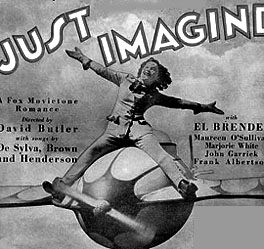
It
flopped, but bits and pieces continued on! |
|
Maureen
O'Sullivan as Miss Number
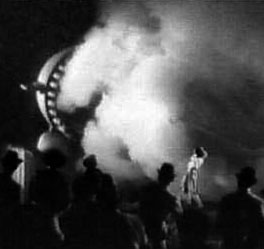
Brave
Mr. Number rockets off for the Red
Planet. |
|
Just Imagine was one of O'Sullivan's early efforts,
where she played a young woman whose name was a number.
Her also-numbered betrothed took a brave chance of piloting
the first Rocket Ship to Mars in order to prove himself
worthy of her hand, which left his true love out of
most of the picture as a result. I think it is also
worth mentioning that Johnny Weismuller later starred
in a B-movie series based on Jungle Jim, thereby
portraying characters created by both Edgar Rice Burroughs
AND Alex Raymond -- similar to Buster Crabbe's career.
Postscript: One of the chimpanzes who played Cheetah
in Weismuller & O'Sullivan's movies was approaching
the age of eighty on the date of this writing -- 2007,
outliving both of her co-stars, and out-acting one of
them, according to a few critics. Maybe they were right,
but I enjoyed Johnny Weismuller's clumsy charm, although
he played a character who was the opposite of Burroughs'
sophisticated Tarzan. Crabbe starred in a mostly-forgotten
Tarzan film himself. Another Crabbe flick, the
laughable Lion Man, drew the wrath of Burroughs
in Tarzan and the Lion Man, which excoriated
the movie industry. James Pierce, Burrough's son-in-law,
played Tarzan on the radio, and in one movie,
as well as portraying Prince Thun in the first
Flash Gordon serial. Raymond reportedly consulted
with Burroughs at times, but this last rumor needs verification,
although I'd love to believe it. |